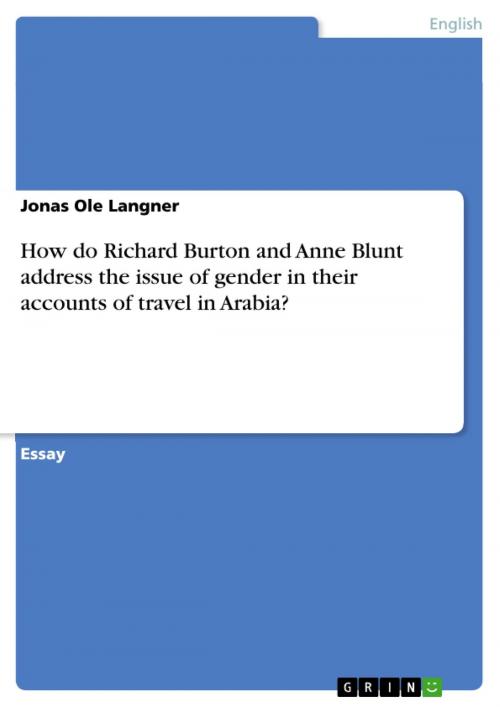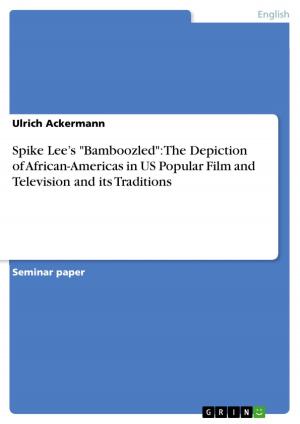How do Richard Burton and Anne Blunt address the issue of gender in their accounts of travel in Arabia?
Nonfiction, Reference & Language, Study Aids, ESL, Foreign Languages| Author: | Jonas Ole Langner | ISBN: | 9783638531047 |
| Publisher: | GRIN Publishing | Publication: | August 7, 2006 |
| Imprint: | GRIN Publishing | Language: | English |
| Author: | Jonas Ole Langner |
| ISBN: | 9783638531047 |
| Publisher: | GRIN Publishing |
| Publication: | August 7, 2006 |
| Imprint: | GRIN Publishing |
| Language: | English |
Essay from the year 2004 in the subject English Language and Literature Studies - Culture and Applied Geography, grade: 2, University of Newcastle upon Tyne, course: Travel Writing and Empire, 8 entries in the bibliography, language: English, abstract: Richard Francis Burton and Anne Blunt both travelled to an Islamic country in the 19thcentury. They both wrote about their journeys - Anne Blunt leftA Pilgrimage to Nejd. The Cradle of the Arab Racebehind, Richard Burton published aPersonal Narrative of a Pilgrimage to Al-Madinah and Meccah- and one can learn from their writings that they encountered partly the same problems or experienced similar incidents. But their accounts also differ from each other in several aspects. Those differences have various reasons; some could be explained by their different destinations, the Nejd and Al-Madinah & Meccah, others emanate from their gender and the constraints the time they lived in brought with that. In order to analyse how Blunt and Burton address the issue of gender in their travelogues, it is important to take different aspects into consideration. Thus '[t]ravel writing cannot be read as a simple account of a journey, a country and a narrator, but must be seen in the light of discourses circulating at this time.' Burton and Blunt wrote about '[...] their travels within a multiplicity of constraints - gender, class, purpose of their journey, textual conventions, audience [...] - which acted upon and formed their writing.' Although both of them travelled to achieve further knowledge about the geography of the countries they went to, Burton's purpose also was '[...] to see with [his] eyes [...] Moslem inner life in a really Mohammedan country [...]'. Therefore, in contrast to Anne Blunt, Burton travelled in disguise and consequently, one can expect them to focus on different things. As a woman Anne Blunt had easier access to harems, whereas Burton had to take on the role of a doctor to get the chance to get into closer contact with women. On the other hand, '[...] it would have been considered improper for a woman writer even to allude to sexual matters.' So, public expectations or rather standards determined the topics women were allowed, but also topics they were expected to write about, such as domestic life; Burton as male person did not see himself confronted with such restrictions. [...]
Essay from the year 2004 in the subject English Language and Literature Studies - Culture and Applied Geography, grade: 2, University of Newcastle upon Tyne, course: Travel Writing and Empire, 8 entries in the bibliography, language: English, abstract: Richard Francis Burton and Anne Blunt both travelled to an Islamic country in the 19thcentury. They both wrote about their journeys - Anne Blunt leftA Pilgrimage to Nejd. The Cradle of the Arab Racebehind, Richard Burton published aPersonal Narrative of a Pilgrimage to Al-Madinah and Meccah- and one can learn from their writings that they encountered partly the same problems or experienced similar incidents. But their accounts also differ from each other in several aspects. Those differences have various reasons; some could be explained by their different destinations, the Nejd and Al-Madinah & Meccah, others emanate from their gender and the constraints the time they lived in brought with that. In order to analyse how Blunt and Burton address the issue of gender in their travelogues, it is important to take different aspects into consideration. Thus '[t]ravel writing cannot be read as a simple account of a journey, a country and a narrator, but must be seen in the light of discourses circulating at this time.' Burton and Blunt wrote about '[...] their travels within a multiplicity of constraints - gender, class, purpose of their journey, textual conventions, audience [...] - which acted upon and formed their writing.' Although both of them travelled to achieve further knowledge about the geography of the countries they went to, Burton's purpose also was '[...] to see with [his] eyes [...] Moslem inner life in a really Mohammedan country [...]'. Therefore, in contrast to Anne Blunt, Burton travelled in disguise and consequently, one can expect them to focus on different things. As a woman Anne Blunt had easier access to harems, whereas Burton had to take on the role of a doctor to get the chance to get into closer contact with women. On the other hand, '[...] it would have been considered improper for a woman writer even to allude to sexual matters.' So, public expectations or rather standards determined the topics women were allowed, but also topics they were expected to write about, such as domestic life; Burton as male person did not see himself confronted with such restrictions. [...]















